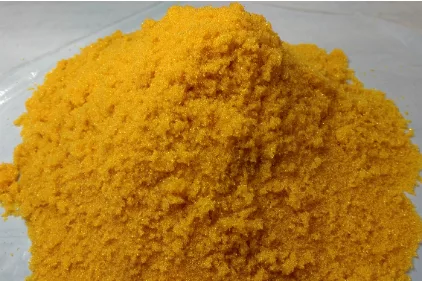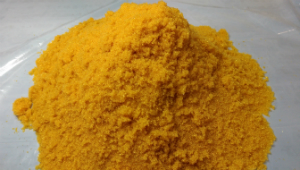EPA Funds Research on Perchlorate in Groundwater
High-Capacity Perchlorate-Selective Resin Research Granted $100,000

As we increase our reliance on groundwater for potable usage, efforts are being made to set standards for acceptable levels of perchlorate, or ClO4, in drinking water.

|
| Current commercial resins are best suited to remove concentrations of perchlorate less than 100 ppb from groundwater. Source: AquaNano LLC |
In light of its goal to promote the development of more cost effective perchlorate removal technologies nationally, the Environmental Protection Agency has granted $100,000 to AquaNano LLC, a start-up company based in Monrovia, Calif., that specializes in water treatment. AquaNano President Han-Ting Chang is the principal investigator of this EPA project.
“This is great for us because we are a small company getting an EPA [small business innovation research grant] to help us continue our work on the development of perchlorate-selective resin,” says Professor Mamadou Diallo, co-founder and chief technology officer of AquaNano. “As a start-up company with limited resources, we feel great about this opportunity.”
AquaNano’s team of scientists and engineers has developed a new generation of perchlorate-selective resins with higher capabilities than the resins currently used to remove perchlorate from groundwater. The grant funds a first phase of research for the company’s R&D program on high capacity perchlorate-selective resins. It has allowed the team to get outside of the lab and test performance in the field. The project ultimately aims to explore commercialization of the resin.
Perchlorate is a major contaminant of United States groundwater sources. When ingested at high concentrations, it can inhibit the uptake of iodide by the thyroid gland and may disrupt its ability to produce hormones critical to developing fetuses and infants. Perchlorate is used in the manufacturing of fireworks, explosives and other pyrotechnics. Contamination of groundwater is found primarily in areas where rocket propellants have been manufactured, used and stored.
“While we are not familiar with this research project and cannot comment on it specifically, we generally approve of research that is aimed to improve the technology available to our industry,” says Kimberly Redden, regulatory and technical affairs coordinator of the Water Quality Association (WQA).
An EPA health goal for maximum allowed perchlorate in U.S. drinking water is pending, but a variety of states have already applied regulations, including California where AquaNano is testing.
The California Department of Public Health established a maximum concentration limit (MCL) of 6 micrograms per liter (µg/L) for perchlorate in drinking water in October 2007 and, in January 2011 proposed to reduce the MCL for ClO4 in drinking water from 6 to 1 µg/L. “So then we focus on the development of the materials, the solution is to achieve that [MCL]. But we’re not involved in the debate about the MCL regulation,” Diallo says.
Massachusetts has established a much lower MCL of 2 µg/L, while Maryland, New Mexico and New Hampshire have set goals for 1 µg/L, according to Redden.
“Today, more than 11 million people have perchlorate concentration in their public drinking water at a concentration of at least 4 µg/L,” she says.
Currently, the best technology for treating perchlorate-contaminated groundwater is single-pass ion exchange with selective and disposable resins, according to the EPA. This technology uses small resin beads that form a positively charged resin bed. When the contaminated water filters through the resin bed, the negatively charged perchlorate is attracted to it. As the perchlorate anions stick to the resin, it releases harmless chloride anions in their place, making the water safe.
Over time, the resin bed is filled with perchlorate and other contaminants like nitrate and chromium, which are also negatively charged and attracted to the resin chloride exchange sites. Once the resin is saturated and can absorb no more contaminants it forms waste brine concentrated with perchlorate, at which point it must be treated and disposed of.
These resins are best suited for treating water with a perchlorate concentration less than 100 ppb. The catch is that many groundwater sources contain higher concentrations of perchlorate.
AquaNano’s higher capacity resins can efficiently remove perchlorate from water with concentrations higher than 100 ppb because they are able to absorb larger amounts of the contaminant before filling up.
It’s ideal to have a resin that runs for a long time before you have to change it out, according to Diallo. “How often you do that really contributes to the cost. You have to haul the resin out and then transport it and dispose it,” he says. “So if you increase concentration [of perchlorate in the water] to 100 ppb with this [new] resin, the frequency of change-out is going to decrease significantly.”
AquaNano’s new perchlorate-selective resin has a higher capacity than the current commercial resin because it has more perchlorate binding sites. This means there are more spots throughout the resin that remove perchlorate anions from groundwater and release harmless chloride anions.
“We are the first ones, as far as I know, that are looking into developing a new generation of resin that has higher capacity than the current resins,” Diallo says. “Anywhere from one and a half to two times the nominal exchange capacity of the [current] resin.”
AquaNano isn’t just working to solve the problem of perchlorate. Its main focus has been testing a solution for chromium 6 removal from groundwater. Diallo says there is no high capacity and selective commercial resin for chromium 6 like there is for perchlorate, so commercializing that resin first could be easier and bring more market interest to their perchlorate resin.
“This is where the EPA grant is very, very helpful for us,” he says. “What the EPA grant is allowing us to do is now also work on perchlorate while we’re working on the development of a selective and high capacity resin for chromium 6,” he says. Taking on two big projects would not have been financially feasible for the startup on its own.
Their next step with the new perchlorate-selective resin is to verify its performance using field tests at municipalities or companies with real perchlorate problems, that have been using existing commercial resins. Diallo says they have secured a testing site, but he cannot disclose the name at this time.
After that, it’s all a matter of finding an investor. “That’s one of the major challenges for a start-up company, is to have enough money to move the idea from the lab to a commercial product,” Diallo says.
The company does not have any commercial products on the market yet, but that is a major goal. The data they are collecting in phase 1 will help develop a roadmap for a phase 2 proposal that aims to accelerate the commercialization of the new perchlorate selective resin.
Diallo says with widespread drought, groundwater is increasingly important. “However, in most states it has one or two contaminants that just make it unusable. So what we’re developing is a means of going there and removing those one, two or three contaminants in a very inexpensive way to make water drinkable.”
Drilling contractors should be mindful of perchlorate occurrence and that it is currently unregulated at the federal level, according to Redden.
“It is advisable that a well drilling contractor work in partnership with a water treatment specialist for perchlorate remediation,” she says. “A full water analysis is recommended to ensure proper treatment setup in the case of multiple contaminants and competing ions.”
Diallo says the next generation of high capacity perchlorate-selective resins will consist of easy-to-install filtration systems for well drillers and that getting those to market is just a matter of time.
“I’m really excited about it right now. We are all excited.”
Valerie King is associate editor of National Driller.
Looking for a reprint of this article?
From high-res PDFs to custom plaques, order your copy today!









